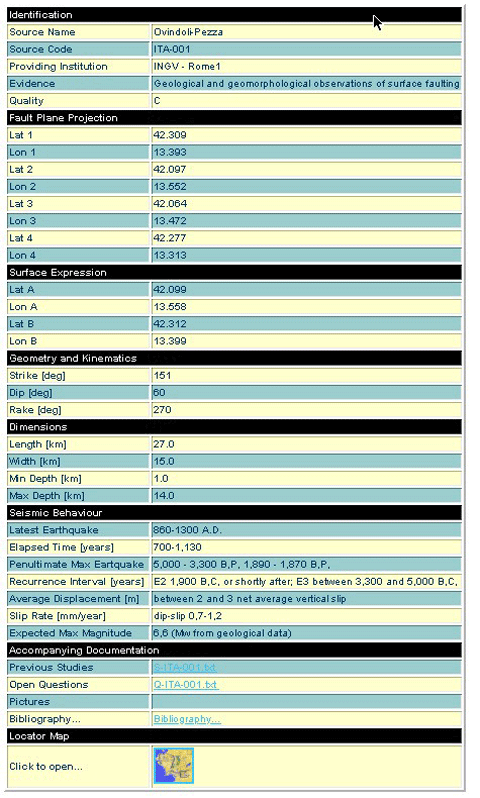

Each source is identified unequivocally by a country code combined with an identification number. Quality rates the source in terms of the reliability of its parameters.
The coordinates of the source edges are expressed as N latitude, E longitude (from Greenwich). The edges are numbered conventionally starting from the northernmost
upper one and moving in the clockwise or anticlockwise direction respectively for a W- or E- dipping plane. Note that edges 1 and 2 are always associated with the upper edge of the box.For surface-breaking faults, the coordinates of the
intersection of the rupture plane with the surface may
coincide with primary surface ruptures; for blind faults, they have a purely geometric significance.
Strike is expressed following the right-hand/eastern dip convention. A N-S fault will strike 0º or 180º for East and West dip, respectively. Dip is angle of rupture plane from horizontal. Rake is 0º, 90º, 180º and 270º respectively for pure left-lateral, reverse, right-lateral and normal slip.
Source dimensions were determined using always (Type B and C sources) or in part (Type A sources) Wells and Coppersmith's [1994] empirical relations. The depth range is generally controlled by instrumental data or geomorphic modelling.
The info on the Seismic Behaviour of the source is mostly derived fron literature (see Previous Studies). The expected Max M is consistent with the postulated source size following Wells and Coppersmith's [1994] empirical relations.
Previous Studies (Type A) summarises work carried out on
the given source by previous workers and the level of knowledge achieved prior to FAUST. Notes (Type B and C) describe the source of the data used in the elaboration, decisions made in the selection of the input data and other relevant info.Open Questions (Type A only) discuss decisions made in the definition of the source parameters and summarises aspects that need further investigations or await confirmation.
Bibliography includes papers that mention the source specifically and papers that deal with the geology, tectonics and historical seismicity of its region.